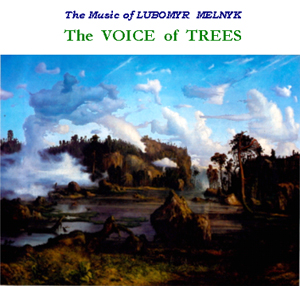The Music of Lubomyr Melnyk
The VOICE of TREES
music for 3 Tubas and 2 Pianos

Recording of the live performance:
Maison de la Danse, Lyon, France, 1985
Complete Performance: 64 minutes
Tubas: Melvyn Poore Pianos: Lubomyr Melnyk
Two virtuosi meet in this dramatic and compelling musical saga.
It is definitely unlike anything you have heard before ...
Melvyn Poore, like Lubomyr Melnyk, has developed a
stunning technical virtuosity, enabling him to create fantastic
and nimble effects on the tuba --- one can hear that these two
musicians simply love their instruments!
This is music for all the senses ... creating mysterious landscapes
that can only be felt and ”seen” with an inner eye.
All music copyright by Lubomyr Melnyk, 1985. All rights reserved.
Cover Art: Lars HERTERVIG ( Norway ) ”Swampland and Forest ”, 1865
The Music of Lubomyr Melnyk
The VOICE of TREES
music for 3 Tubas and 2 Pianos
Recording of the live performance:
Maison de la Danse, Lyon, France, April 20,1985
with the Kilina Cremona-Roger Meguin Danse Company
- Complete Performance -
Tubas: Melvyn Poore
Pianos: Lubomyr Melnyk
Melnyk composed this music for Kilina Cremona, the choreographer and dancer, whom he had met during his years in Paris . Cremona was a fond enthusiast for the work of Merce Cunningham, and Melnyk, who was fond of John Cage's work, naturally came together with this vibrant dancer whose honesty and devotion to art were to inspire him and remain a solid foundation in his own efforts in music.
Together, Melnyk and Cremona collaborated in three large productions, involving the Kilina Cremona Dance Company and the composer-pianist. (Melnyk in general worked very often with choreographers who used his Continuous Music as a ”background- platform” for their dance works.) Each would work on their own, quite separately, and the two elements, the dance and the music, would come together first only in the final rehearsals.
The ballet had a different name, ”ESCIA” but this music has its own title, chosen by Melnyk for his music, since it drew for him a landscape that seemed to speak with ”the voice of trees.... of solitary and stately trees that stand in the face of brutal natural forces that strive to destroy them, .....”
The Voice of Trees is composed partially in ”Geometric Form”, a type of musical composition that Melnyk created, (after the works of the Russian philosopher and mystic Ouspensky), whereby the musical events are dictated by mathematics and the Fourth Dimension. (It was actually Kilina Cremona who introduced Melnyk to the works of the mathematically oriented Ouspensky). Melnyk was here also influenced by John Cage, who used pure chance as an element of structuring time and sound.
This would be a formal element in several of his compositions from the late 70's up to the mid-80's.
Melnyk met Melvyn Poore in Lyon , France prior to the premiere. There, the two worked together on interpreting the musical elements his particular work was taken on tour with the dance company to several cities in France and Switzerland . It was even performed at the Centre Pompidou in Paris .
The relationship between Melnyk's Continuous Music and the dance (or ballet), was rather free; the music had its own time, and the dancers had theirs. Together, they created a visual and aural unity that defied the standard artistic norms .... this would be an undefinable but stimulating artistic experience for the public, something to elevate their souls and daily lives .. an all-encompassing hour of mixed dimensions.
It demanded incredible discipline and hard work on the part of the dancers ... and the musicians. This was not a performance for union scale – this was an act of devotion and love for Art, and demanded the entire body and soul of the participants – both the dancers AND the two musicians!
This recording is from a ive performance. Since no other pianist possessed the technique required to perform this difficult work, Melnyk had to perform both piano parts, using the same method he has employed in nearly all of his multi-piano works --- he pre-taped the First Piano part, (together with Melvyn Poore's First Tuba part) .... then a second free-unaligned Tuba part (Tuba-III-) tape was recorded onto a second recording machine, and these two tapes were then played, with Melnyk and Poore performing the Piano/Tuba Part -II- live on stage with the dancers.
You may hear occassionally the sound of the dancers' feet, although most of the ”non”musical sounds actually come from the Tuba-III- part, where the player must create certain sound effects on the instrument. It should be noted that no electronic manipulation whatsoever was done to the recordings – all you hear is pure natural sounds from the live instruments.
Note: Cd sound is very inferior to true H-Fi recordings ... Cd-s are also extremely fragile to both time and general use. Therefore we recommend that you make a back-up archive-copy of this Cd . For those who appreciate true Hi-Fidelity sound, we recommend that you contact us for high-end cassette copies made from the Hi-Fi analogue master-tapes.
Back to list of recordings
|







